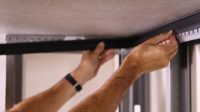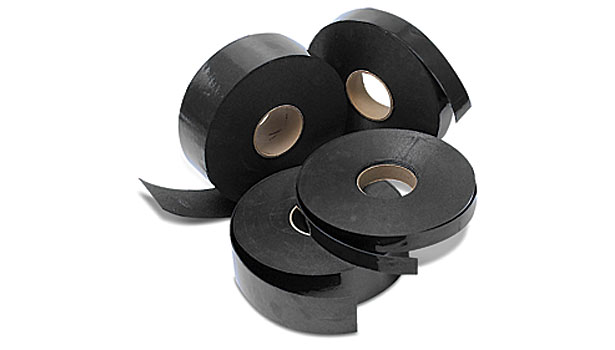Intumenscent Tape |
| Introduction |
| The Dilemma |
| Solution |
| Conclusion |
Intumescent tape has changed the fire-stopping industry for the better over the last few years and is now doing the same for sound walls. Once primarily used for fire-rated doors, safes and gun cabinets, intumescent tape is now used for building joints with phenomenal results for fire and sound protection.
As structural engineers continue to design buildings requiring more and more dynamic movement, the benefits of intumescent tape could not have come at a better time. The reason intumescent tape works so well is because it’s relatively thin and can be concealed within the framing assembly without hindering movement. However, intumescent tapes can’t merely be “field-installed” into the framing assembly. The position and location of the intumescent tape is critical to the effectiveness of the joint assembly. That is why steel/intumescent composite tracks are tested and certified with Underwriters Laboratories. Each building joint assembly is tested through UL according to UL-2079 Tests for Fire Resistance of Building Joint Systems.
Some intumescent tapes expand up to 35 times their original size. With this type of performance it’s no wonder steel framing manufactures have sought out different ways to utilize the capabilities of intumescent tapes. CEMCO FAS Track 1000 is just one example of the efficient use of intumescent tape within a steel deflection track. Intumescent tape is attached to the upper web along the outer edges similar to what contractors have done for years with foam tape to increase STC or IIC sound ratings. The tape works as a gasket, sealing off irregularities in the structure. It also works as an isolator lending a sound deadening element to the deflection track. This type of fire-rated deflection track can increase STC ratings of the wall assembly without the traditional usage of fill materials such as acoustic sealant that can prohibit the amount of dynamic movement.
Currently, field applied sealants at the head-of-wall, whether they are acoustic or fire sealant can drastically reduce the movement capabilities of the joint. In recent year’s sealant manufacturers have responded to this issue by making the head-of-wall joints wider with more flexible material so they can provide greater movement. The typical sealant filled head-of-wall joints can range in size from 3/4 to 1 inch wide, and although the larger joint will provide more movement they generally will not get more than 1/4 inch compression or extension before they tear away from the drywall, leaving an unprotected gap within the building joint. A tear or crack in a sealant filled joint system means it has failed as a fire stop before it has even been called upon to perform.
THE DILEMMA
Most concrete multi-family structures, such as hotels or condos, require 3/4 inch overall movement. At the same time the UBC requires Sound Transmission Class ratings and Impact Insulation Class ratings for dwelling units, which include hotels, motels, apartments, condominiums, dormitories, and monasteries to be at a minimum 50 STC or IIC rating. Sound ratings can be greatly reduced through sound flanking paths. To reduce flanking paths, drywall should be sealed tight to the framing member around the perimeter. However, in traditional metal stud framed walls, framing screws that attach the stud to the track cause the drywall to hump up around the framing screw that provides a flanking path and increases sound transmission. Sound ratings can also be reduced in metal stud framing at the hard connection between the metal track and the floor or ceiling. For this reason, resilient partition isolation pads, acoustic sealant or foam tapes are sometimes utilized between the track and the ceiling or floor to reduce the potential sound loss due to flanking paths. But none of these sound aids provide fire protection if movement is required.
What’s the contractor to do? On one hand, you have to provide an average of 3/4 inch overall movement for the building structure. On the other hand, you are required to provide applicable sound protection for dwelling units. Traditionally sound protection and fire protection do not work hand in hand when movement is involved.
Making matters worse, contractors are bidding projects in a very competitive environment these days and in the past the traditional means and methods of a sealant filled head-of-wall joints were not watched very closely by the inspectors. So head-of-wall fire rated joints could be done relatively inexpensively by installing smaller width joints of 1/4 to 1/2 inch which will save material and labor costs rather than what is actually called out on the UL report at 3/4 to 1 inch. When you take into consideration the overall movement is based on the width of the joint and the percentage of the compression or extension listed on the UL report (typically listed at 18 to 25 percent) it is clear that making the joint smaller will only limit the amount of movement causing the joint to underperform. Most buildings are designed with a certain movement criteria. Certain walls within all structures are also designed to be fire-rated to enable safe egress hence the requirement for fire-rated walls with dynamic movement. A fire-rated joint that underperforms may not sound like a big deal during construction but if by underperforming the joint splits open and allows smoke to pass through the wall it can put lives at risk.
SOLUTION
Find out the movement requirement of the building structure and find a joint system that will provide it. If the UL report requires a 1-inch joint filled with a particular type of fire sealant then install it accordingly. If acoustic or fire sealant will not provide enough movement find something that will. There are deflection tracks with factory applied intumescent tapes, such as CEMCO FAS Track 1000, that will provide fire, smoke, and sound protection. This product is certified through UL according to UL-2079 and can meet greater deflection requirements with no fatigue splitting or cracking.
But what if the project is already underway and the top track is already installed when you, the contractor find out the movement requirement is greater than what is achievable with fire sealant? It’s a little too late to switch out the installed deflection track for one with a factory applied intumescent tape. There is a solution.
CEMCO DDA (Deflection Drift Angle) is a light gauge composite steel angle with intumescent tape along the inside leg which can be tapped into place over the leg of the installed top track. There are no mechanical fasteners required for installation. The 3/4-inch horizontal leg of the product is friction fit between the web of the track and the overhead structure. This allows the wall assembly to move vertically and laterally without compromising the fire stop material. This type of fire-stopping product has other advantages; provides a universal fit for any wall width, gauge, height, whether the wall is standard, shaft wall, radius, or raked. It can go over either slotted or deep leg deflection track and finally it can provide up to 1¾-inch unencumbered joint protection.
CONCLUSION
Do your research when selecting head-of-wall fire protection. Make sure the manufactures joint system has been tested according to UL-2079 “Tests for Fire Resistance of Building Joint Systems” and can provide the movement the building structure requires. If you decide to go with a steel/intumescent deflection track, make sure it has been sound tested and can meet the required STC rating. Finally, field installations can be very difficult make sure the joint system is being constructed as intended and described in the UL report. Underperforming joints are unacceptable, especially in multi-family dwellings. W&C
























